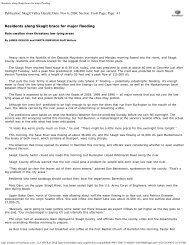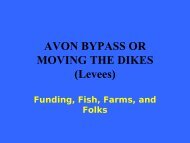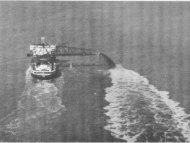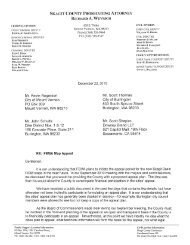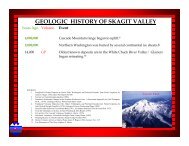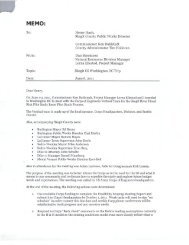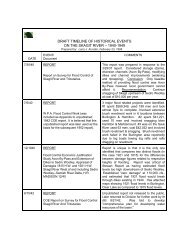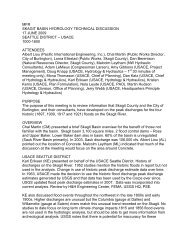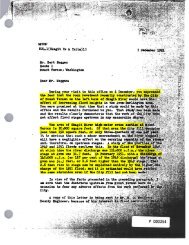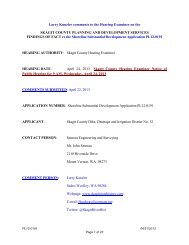Procedures for Compliance with Floodway Regulations.pdf
Procedures for Compliance with Floodway Regulations.pdf
Procedures for Compliance with Floodway Regulations.pdf
Create successful ePaper yourself
Turn your PDF publications into a flip-book with our unique Google optimized e-Paper software.
Cross Section A<br />
Encro.1Chmcnl<br />
flood fringe<br />
floodway<br />
Ellcroachment<br />
Plan View<br />
Figure I: <strong>Floodway</strong> and <strong>Floodway</strong> Fringe<br />
2. The National flood Insurance Program<br />
Encroachment Permilled<br />
A<br />
noon<br />
fringe<br />
•<br />
Encro"c1l1nent Permined<br />
2-1. Overview. The National Flood Insurance Program (NFIP) was created<br />
by Congress lhrough the passage ofthe National Flocxf Insurance Act of 1968.<br />
The purJX>5e of the NFIP is twofold: 1) to provide the general public the<br />
opportunity to obtain insurance coverage to cover flood damages to buildings<br />
and their contents and, 1) to reduce future flood damages by requiring the<br />
local regulation of new development in floodprone areas. The NFIP is<br />
administered by the Federal Insurance Administration (FIA), a division of the<br />
Federal Emergency Management Agency (FEMA).<br />
The availability of flood insurance is contingent upon a community'S<br />
participation in the NFIP. To participate, a community must enact regulations<br />
10 control development activities <strong>with</strong>in identified floodplain areas. Local<br />
A<br />
regulations must meet or exceed minimum NFIP requirements. There are over<br />
17,000 municipalities currently participating in the NFIP, nationwide.<br />
FloodplQne areas are idenrified on maps provided to communities by the<br />
Federal Insurance Administration. Referred to as Special Flood Hazard Areas,<br />
the~ areas represent the extent of inundation which can be expected from a<br />
100 year flood or base flood. local regulations must ensure that all new and<br />
substantially improved buildings are prOleaed 10 the level of the base flood.<br />
allhe very minimum.<br />
For municipalities <strong>with</strong> Flood Insurance Studies, the identified floodplain<br />
is divided into two distina zones or distrias: a floodway and floodway fringe<br />
(see figure 1). The f100dway is delineated <strong>for</strong> the purpose of keeping an area<br />
clear of obstructions to allow flood waters to freely discharge downstream.<br />
When f100dways are identified, municipalities must include regulations<br />
which restrict any new development <strong>with</strong>in noodwar-; which would cause<br />
any increase in nood heights. There is no such restrioion to development<br />
<strong>with</strong>in the floodway fringe. Development may occur in the f100dway fringe<br />
provided it complies <strong>with</strong> applicable elevation or floodproofing requirements.<br />
The Federal Insurance AdminiSlration uses special criteria in delineating<br />
f100dways. In an attempt to allow <strong>for</strong> some development in floodplains, FIA<br />
decided to delineate f100dways assuming that development may take place<br />
<strong>with</strong>in floodway fringes to an extent that flood heights will be raised a<br />
maximum of one foot. Some states have enacted more stringent surcharge<br />
limits, but, <strong>for</strong> the most part, the NFIP floodway criteria and delineation is<br />
widely used. The following seaiolls attempt to clarify NFIP floodway regulations<br />
and the proper procedures and data needed to evaluate development<br />
proposals.<br />
2.1 General Oevelopmenl <strong>Procedures</strong>. It is the responsibility of the<br />
builder, developer. or property owner to obtain a local permit be<strong>for</strong>e proceeding<strong>with</strong><br />
any construoion or development <strong>with</strong>in an identified floodplain area.<br />
The definition of del'eloDnlenl as defined through the NFIP is as follows:<br />
allY /tUl1r-made challge t(l improved or ullImproved real estate. i"dudi"g but 1101<br />
IinUled to bU/fdlllgs or Olher Structures. milling. dredgurg. fillillg. gradillg.<br />
pavmg. excavation. drilling operations or J,loraKe 01 equipment or matt!flafJ..<br />
As one of the conditions <strong>for</strong> obtaining local approval. an applicant must<br />
secure all other necessary federal and state permits which are required <strong>for</strong> the<br />
location and type of development being proposed. Many states have permit<br />
requirements and regulations pertaining to development activities in the<br />
f100dway. The U.S. Army Corps of Engineers and various states have strict<br />
regulations concerning the development of wetlands. While il is the responsibility<br />
of the applicant to obtain these and other applicable governmental<br />
permits, it is incumbent upon communities participating in the NFIP to<br />
<strong>with</strong>hold the issuance of a local permit until such time that the applicant<br />
provides evidence that all necessary permits have been secured.<br />
2 3



